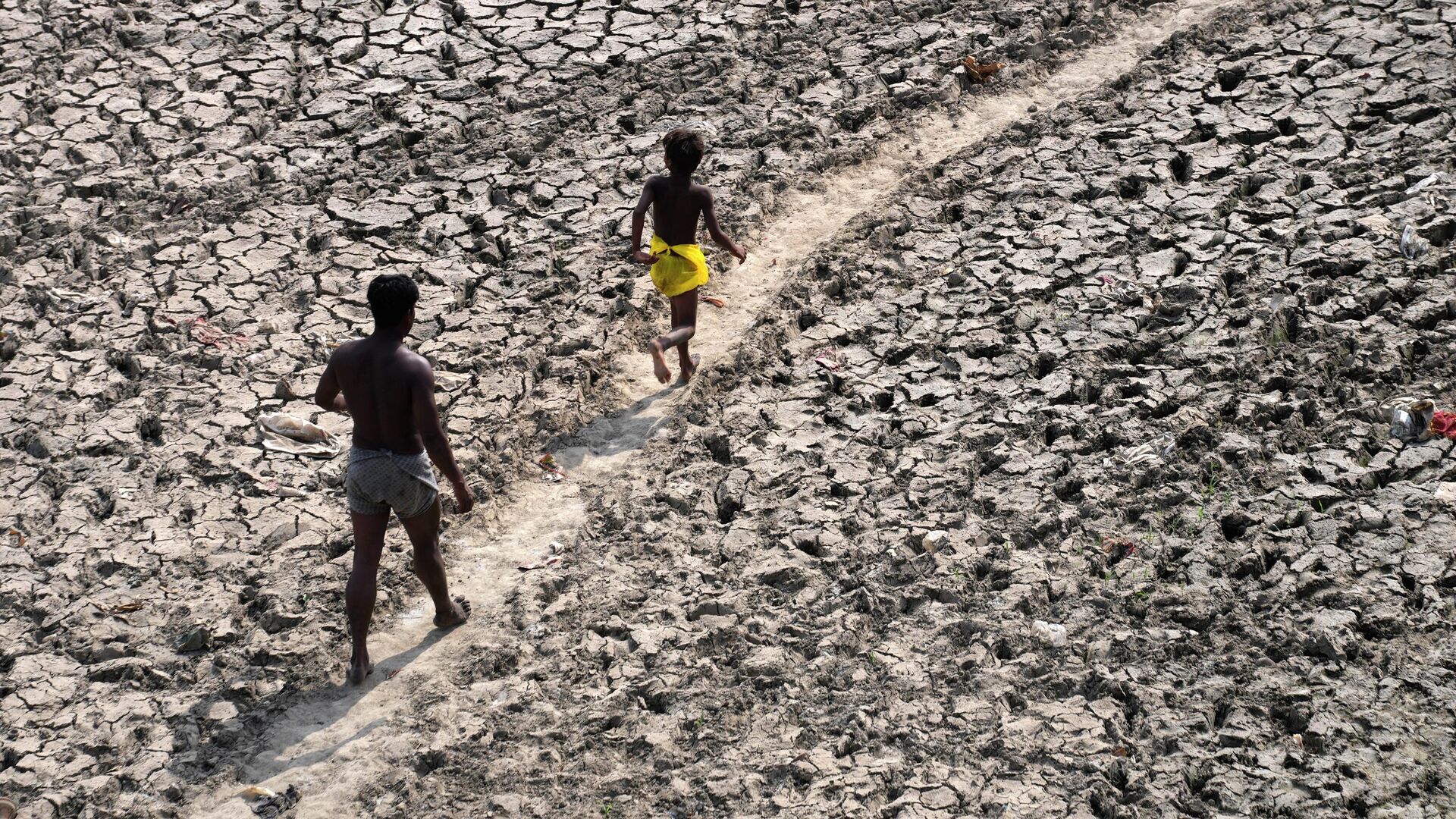https://sputnikglobe.com/20220517/delhiites-face-water-shortage-as-citys-only-river-almost-dries-up-1095561994.html
Delhites Face Water Shortage as City's Only River Almost Dries Up
Delhites Face Water Shortage as City's Only River Almost Dries Up
Sputnik International
Delhi, which is currently experiencing a sweltering summer, has seen a 60-90 percent rain deficit, or more, from March to mid-May, impacting the water level... 17.05.2022, Sputnik International
2022-05-17T10:21+0000
2022-05-17T10:21+0000
2022-07-19T10:43+0000
delhi
new delhi
water shortage
water supply
water
water
water supplies
https://cdn1.img.sputnikglobe.com/img/07e6/05/11/1095567049_0:260:3072:1988_1920x0_80_0_0_32847b77659735226510d3f1453658c9.jpg
With the temperature crossing 49 degrees Celsius, Delhi is experiencing sweltering heat and the residents are facing a disruption in the water supply.With a population of about 20 million, Delhi lacks water due to the depletion of the level of the Yamuna River at the Wazirabad point, as well as due to a reduction in the release of water in the river canal by its neighbouring state of Haryana."Water supply in Wazirabad, Chandrawal and Okhla -- the three water treatment plants (WTPs) has dipped further. River Yamuna has almost dried up. Supply from these plants will be affected almost 40-60 percent", a Delhi Jal Board (DJB) official told Sputnik on Tuesday.The Delhi Jal Board is the city government's agency responsible for the water supply.The official said that Delhi's northeast, west, north, central, and south, including Delhi Cantonment, as well as the New Delhi Municipal Council areas will see disruption. "The water tankers would be provided on request as supply would remain affected till the pond level improved to normal", the official further stressed.Generally, Delhi requires about 950 million gallons per day (MGD), with the demand peaking in the summer as high as 1,200 MGD.In the last 15 days, the Aam Aadmi Party-led city government has written to the neighbouring Bharatiya Janata Party-led Haryana government three times, urging them to increase the water supply in the Yamuna. But the request has not been accepted so far.Last year, on 11 June, when the river's water level dropped to 667 feet, the DJB moved the Supreme Court seeking directions for Haryana to release additional water in the Yamuna.On Monday, the water level in the Wazirabad waterworks pond dipped to 669.40 feet, the lowest so far this year.In the 1990s and early 2000s, Delhi had 629 recognised water bodies and approximately 500 undocumented ones, which were the main source of providing drinking water to residents. But now, 70 percent of the water bodies have completely dried up and even the remaining water is not fit for drinking. In 2016, the DJB identified 100 ponds for revival and clean-up, but no progress has been made.
delhi
new delhi
Sputnik International
feedback@sputniknews.com
+74956456601
MIA „Rossiya Segodnya“
2022
Deexa Khanduri
https://cdn1.img.sputnikglobe.com/img/07e4/0c/1e/1081607388_0:0:961:960_100x100_80_0_0_e9e931b8c1e18fb41f3074e2145d7a3a.jpg
Deexa Khanduri
https://cdn1.img.sputnikglobe.com/img/07e4/0c/1e/1081607388_0:0:961:960_100x100_80_0_0_e9e931b8c1e18fb41f3074e2145d7a3a.jpg
News
en_EN
Sputnik International
feedback@sputniknews.com
+74956456601
MIA „Rossiya Segodnya“
Sputnik International
feedback@sputniknews.com
+74956456601
MIA „Rossiya Segodnya“
Deexa Khanduri
https://cdn1.img.sputnikglobe.com/img/07e4/0c/1e/1081607388_0:0:961:960_100x100_80_0_0_e9e931b8c1e18fb41f3074e2145d7a3a.jpg
delhi, new delhi, water shortage, water supply, water, water, water supplies
delhi, new delhi, water shortage, water supply, water, water, water supplies
Delhites Face Water Shortage as City's Only River Almost Dries Up
10:21 GMT 17.05.2022 (Updated: 10:43 GMT 19.07.2022) Deexa Khanduri
Sputnik correspondent
Delhi, which is currently experiencing a sweltering summer, has seen a 60-90 percent rain deficit, or more, from March to mid-May, impacting the water level bodies.
With the temperature crossing 49 degrees Celsius, Delhi is experiencing sweltering heat and the residents are facing a
disruption in the water supply.
With a population of about 20 million, Delhi lacks water due to the depletion of the level of the Yamuna River at the Wazirabad point, as well as due to a reduction in the release of water in the river canal by its neighbouring state of Haryana.
"Water supply in Wazirabad, Chandrawal and Okhla -- the three water treatment plants (WTPs) has dipped further. River Yamuna has almost dried up. Supply from these plants will be affected almost 40-60 percent", a
Delhi Jal Board (DJB) official told Sputnik on Tuesday.
The Delhi Jal Board is the city government's agency responsible for the water supply.
The official said that Delhi's northeast, west, north, central, and south, including Delhi Cantonment, as well as the New Delhi Municipal Council areas will see disruption.
"The water tankers would be provided on request as supply would remain affected till the pond level improved to normal", the official further stressed.
Generally, Delhi requires about 950 million gallons per day (MGD), with the
demand peaking in the summer as high as 1,200 MGD.
In the last 15 days, the Aam Aadmi Party-led city government has written to the neighbouring Bharatiya Janata Party-led Haryana government three times, urging them to increase the water supply in the Yamuna. But the request has not been accepted so far.
Last year, on 11 June, when the river's water level dropped to 667 feet, the DJB moved the Supreme Court seeking directions for Haryana to release additional water in the Yamuna.
On Monday, the water level in the Wazirabad waterworks pond dipped to 669.40 feet, the lowest so far this year.
In the 1990s and early 2000s, Delhi had 629 recognised water bodies and approximately 500 undocumented ones, which were the main source of providing drinking water to residents.
But now, 70 percent of the water bodies have completely dried up and even the remaining water is not fit for drinking.
In 2016, the
DJB identified 100 ponds for revival and clean-up, but no progress has been made.




